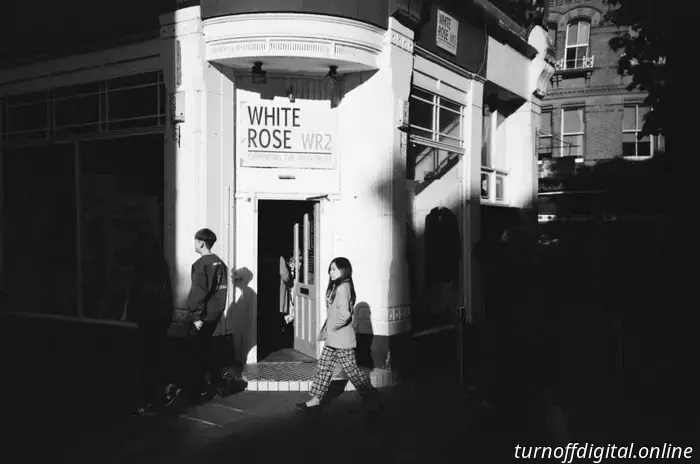
I shot this on JCH Street Pan 400 using the Lomo LC-AI. These days, I don’t shoot as much film as I used to, so I need to make each shot count. By that, I don't just mean ensuring I capture good images; that's certainly part of it, but I mean that if I’m dedicating my time to this, it needs to be worthwhile. I want to enjoy the process.
A few years back, I loved visiting a ruined abbey in England to take my time shooting it with Ilford Delta 100 in a Yashica Electro, which I actually bought years ago from Dmitri, who runs this site. Using sharp film in an older camera with a quality lens is great for showcasing both. However, it's no longer something that interests me.
Here’s an image from that outing, taken on Ilford Delta 100 with the Yashica Electro. While it's fine for what it represents, it’s not how I want to spend my time anymore.
I now prefer to explore towns or cities, especially on sunny days. I load some high-contrast ISO 400 black-and-white film into a user-friendly camera and embrace the experience. I really enjoy the original Soviet Lomo LC-A—when it works, that is. Unfortunately, it doesn’t always function correctly, and as I'm writing this, mine needs repairs. However, it performed well on the day I captured these images with JCH Street Pan 400—mostly, as you’ll see later.
Let me wander through a town or city, like Nottingham in this case, with that camera and film combination under good lighting, and I’ll be a happy person. I’ll take the first few shots of the roll to get warmed up, then I’ll likely grab a pint before returning for more shooting.
People may glance your way, but that’s alright; the Dutch courage helps me maintain my confidence. What I find enhances my photography is that it makes me less concerned about the outcome—I mean more carefree rather than careless.
I believe the Lomo LC-A is often undervalued and misunderstood. It's seen merely as a tool for vibrant colors, vignettes, unexpected mishaps, and subpar pictures branded as Lomography. While some of that is true, it’s also so much more. It’s my preferred camera for the type of photography I’m sharing here, capable of producing better images than many who haven't tried it realize.
The best bit of advice I received about photography is that the light is always the subject of a photograph. You might argue against that or identify exceptions, but I find it to be the most beneficial guideline for capturing images I like. To me, an intriguing subject in poor lighting will never surpass an ordinary subject in great light in terms of visual appeal.
Juggling chainsaws is certainly more impressive than simply walking, but our focus here is not on physical feats—it's about the art of photography. An everyday scene, like someone strolling past a regular store in good light, will nearly always result in a more visually engaging photograph than capturing something exceptional in flat lighting.
As I mentioned, my Lomo LC-A is my favorite when it’s functioning well, though due to its nature, it doesn’t always perform as I’d like. Recently, I’ve faced issues with it not properly advancing frames, leading to some overlaps, like what you see on the left and right in these shots.
The upside is that I can stitch those overlapping images together in Photoshop to create unique multiple exposure panoramas. While the Lomo LC-A has its flaws, don’t be surprised if it malfunctions. However, when it does, why not strive to make something out of the unintended results?
I already shared my love for the Lomo LC-A, but I must reiterate my fondness for the results from JCH Street Pan 400 as well. On that day in Nottingham, both the camera and film came together to produce images worth sharing.
Yet, I can’t credit just the camera and film—I have to acknowledge my role in it too. After all, it was I who ventured out with both and captured the shots in my preferred style of photography, which I enjoy most.
While I may dabble in other styles in the future, I plan to leave landscapes, portraits, pastel-colored houses on Portra, and gas stations on CineStill to others. Give me ISO 400 monochrome film, the LC-A, and enough money for a couple of pints throughout the afternoon. That’s my favorite way to shoot film, and the kinds of images you’ve seen here are the ones I love creating.
I no longer shoot film as frequently as I once did, so I need to make each shot valuable. And by that, I don't just mean ensuring the photos turn out well, which is certainly part of it. Rather, I mean that if I'm going to invest my time in this, it needs to be meaningful.